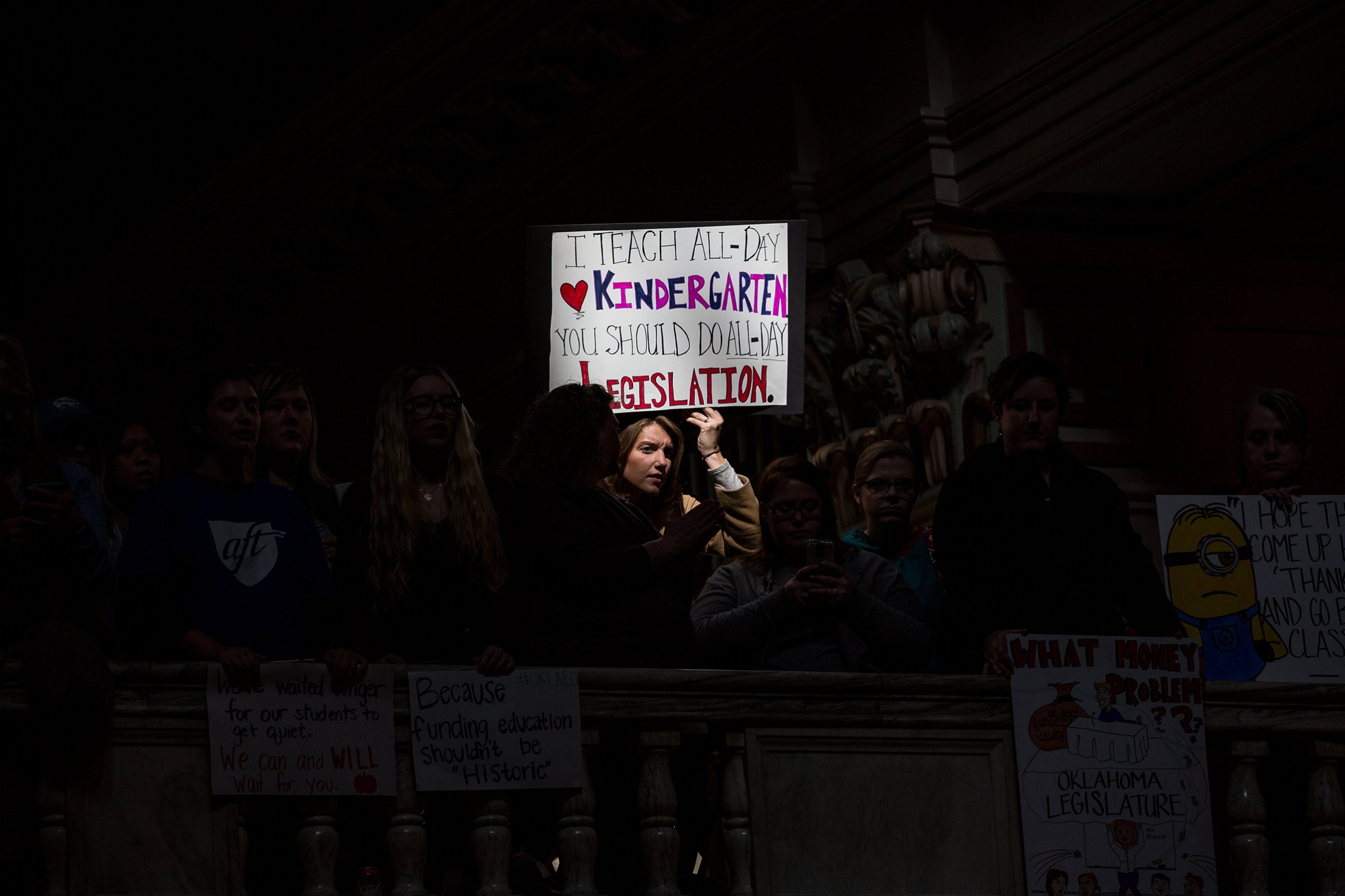
Amber Spradlin tolerated the indignities of public-school teaching for 13 years, but now she has had enough. “We have tried so many different things, so many different avenues, to advocate for our students,” she says. “Finally, we were saying, ‘We’re not going to take this anymore.'”
Spradlin, a sixth-grade English teacher in Choctaw, Okla., was at the state capitol in Oklahoma City on April 9, missing her sixth day of work in order to demand more school funding. She’s part of a wave of teacher actions that has lately swept Republican-led states, as well as an example of this moment’s political archetype: a woman who is fed up and ready to do something about it.
Fed-up women have been driving the political cycle since November 2016. The January 2017 Women’s March is believed to have been the largest single-day protest in U.S. history. Record numbers of women are running for office, with many citing the 2016 election as a spur to action. The #MeToo movement has emboldened women across industries to speak up against sexual harassment and misconduct. Women have been major drivers of protests on health care and gun control. If Democrats score big in November’s midterm elections, as most prognosticators believe they will, angry women will be the reason.
The teachers who have gone on strike in Oklahoma and elsewhere are not all women and have not branded their campaign as a women’s issue, but the numbers speak for themselves. Seventy-seven percent of public-school teachers are women, according to the National Center for Education Statistics. The idea that teaching is “women’s work” is also part of the reason the profession is chronically underpaid, says Randi Weingarten, president of the American Federation of Teachers union.
The current strikes began in West Virginia in February, when a grassroots groundswell begot a nine-day walkout and ended with a 5% raise. In Oklahoma, teachers already won a raise but strikers say they won’t return to work without more overall school funding too. In Kentucky, teachers have swarmed the capitol and some districts have shut down to protest a bill reducing pension benefits. On April 11, teachers in Arizona stepped into the fray, staging demonstrations after the state’s governor, Doug Ducey, rejected a 20% raise.
The wave may not stop there. Several other states have the ingredients–from spending cuts to labor laws–that have contributed to the strikes, and rumblings have already begun in North Carolina.
The conditions that have led to the strikes have shocked even education experts. In 39 states, teachers’ salaries have declined since 2010; many are also being asked to pay more for benefits, reducing their take-home pay even as private-sector wages rise. Strikers have called attention to crumbling classrooms, ancient textbooks, crowded conditions and teachers who work multiple jobs to get by. “Many states’ budgets have mostly recovered from the Great Recession, but not all of them resumed their levels of investment in education,” says Michael Hansen, an education-policy scholar at the Brookings Institution.
The teachers have taken pains to paint their movement as a nonpartisan one, but their targets are the Republican governors and legislatures whose zeal for cutting taxes and spending has led to the funding crunch. And their leverage over lawmakers is the threat of revenge at the polls if they don’t get what they want.
There are already signs that women’s activism is powering Democrats. Virginia’s new Democratic governor won votes from women by a wider margin than Hillary Clinton, and Democrat Doug Jones’ December upset in Alabama was powered by a 16-point advantage among women. The percentage of women who identify with the Democratic Party has risen 4 points since 2015, according to the Pew Research Center; among millennial women, the increase is 14 points. Amanda Carpenter, a conservative commentator and consultant, says the GOP should be worried. “How can you have a conversation with women voters when your party supports Trump?” she says.
States like Oklahoma aren’t likely to go purple soon. But 36 states–two-thirds of them Republican-led–have gubernatorial elections this fall. If the teachers are any indication, the pink wave could wash over them all.
Spradlin, the Oklahoma teacher, says she takes home about $1,900 per month and dips into that money for many classroom supplies. After years of frustration watching politicians fail to act, she says, it feels good to take matters into her own hands. “All the teachers and students,” she says, “are here saying, ‘We’re not leaving.'”
More Must-Reads from TIME
- Donald Trump Is TIME's 2024 Person of the Year
- Why We Chose Trump as Person of the Year
- Is Intermittent Fasting Good or Bad for You?
- The 100 Must-Read Books of 2024
- The 20 Best Christmas TV Episodes
- Column: If Optimism Feels Ridiculous Now, Try Hope
- The Future of Climate Action Is Trade Policy
- Merle Bombardieri Is Helping People Make the Baby Decision
Write to Molly Ball at molly.ball@time.com